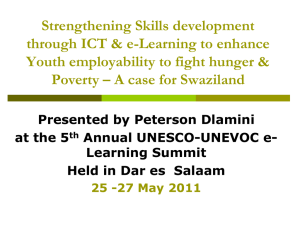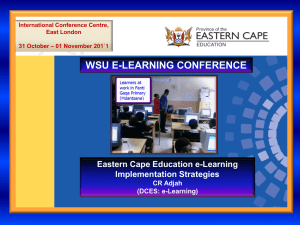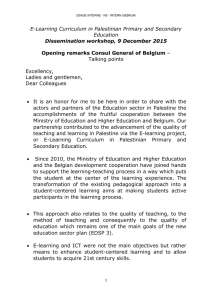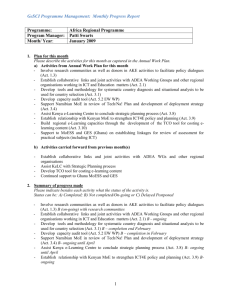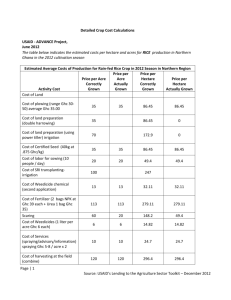This project has provided additional documentation
advertisement
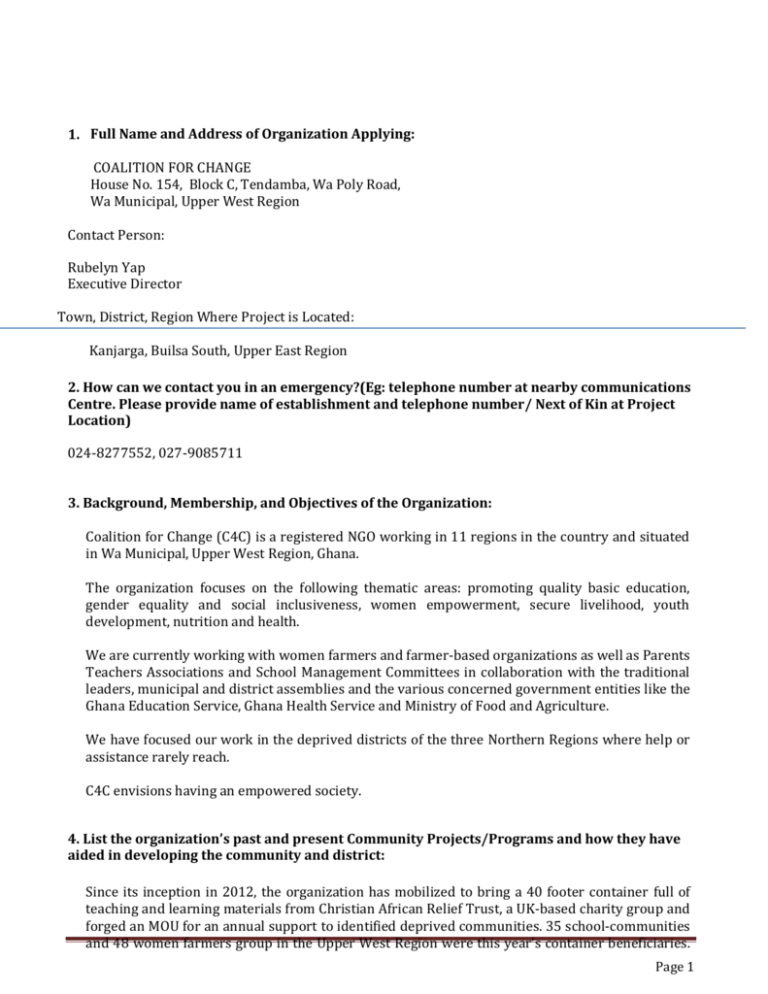
1. Full Name and Address of Organization Applying: COALITION FOR CHANGE House No. 154, Block C, Tendamba, Wa Poly Road, Wa Municipal, Upper West Region Contact Person: Rubelyn Yap Executive Director Town, District, Region Where Project is Located: Kanjarga, Builsa South, Upper East Region 2. How can we contact you in an emergency?(Eg: telephone number at nearby communications Centre. Please provide name of establishment and telephone number/ Next of Kin at Project Location) 024-8277552, 027-9085711 3. Background, Membership, and Objectives of the Organization: Coalition for Change (C4C) is a registered NGO working in 11 regions in the country and situated in Wa Municipal, Upper West Region, Ghana. The organization focuses on the following thematic areas: promoting quality basic education, gender equality and social inclusiveness, women empowerment, secure livelihood, youth development, nutrition and health. We are currently working with women farmers and farmer-based organizations as well as Parents Teachers Associations and School Management Committees in collaboration with the traditional leaders, municipal and district assemblies and the various concerned government entities like the Ghana Education Service, Ghana Health Service and Ministry of Food and Agriculture. We have focused our work in the deprived districts of the three Northern Regions where help or assistance rarely reach. C4C envisions having an empowered society. 4. List the organization’s past and present Community Projects/Programs and how they have aided in developing the community and district: Since its inception in 2012, the organization has mobilized to bring a 40 footer container full of teaching and learning materials from Christian African Relief Trust, a UK-based charity group and forged an MOU for an annual support to identified deprived communities. 35 school-communities and 48 women farmers group in the Upper West Region were this year’s container beneficiaries. Page 1 Various items to include books, learning materials, furniture and fixtures, clothes, bicycles, spots equipments, farming tools among others were distributed to these groups. The organization also funded and supported the training of women extension volunteers from April 2013 to October 2013 under the Women Extension Volunteer Programme which covers the districts of Lambussie, Jirapa, Lawra, Nadowli, Sissala East, Sissala West, Wa West and Wa Municipal. The series of agricultural and skills development training is geared towards enhancing their basic knowledge of farming techniques for them to assist the various farmer’s group and their community as well. This programme was conducted in collaboration with the Women in Agricultural Development of the Ministry of Food and Agriculture-Upper West Region. 6. a.i. Type of project for which we are currently seeking assistance: We are seeking assistance to refurbish an E-Learning Centre in the community of Kanjarga in Builsa South District in Upper East Region through provision of computer sets and laptops, servers, software, ICT data and broadband connections. We also need multi-media computers for children office equipment, audio visual equipment, furniture and fixtures and books. Capacity building is also necessary for the personnel to manage and operate the centre for sustainability. a.ii. Why the need for this particular project? Why does the community need it? Justify your answer and add current pictures of the situation. Upper East has a total population of 1,045,545 (2010 CENSUS) with an annual growth rate of 1.2%. 870,294 or 83% of the population is of school going age, however, only 23% is enrolled in primary school and the statistics shows a continuous declining trend of only 7% reaching to Junior High School and only mere .5% completing Secondary school. The drop-out rate is very alarming as the state of poverty also worsens in the area. The region literacy rate is 32%. In Builsa where the proposed project is located, the district comprises 9% (92,991) of the region’s population and it has the same educational trend. Out of the school going age in the District, only 65% is enrolled in the primary school and only 12% reaches Junior High School with only 5% completing Secondary School. The sharp increase of the drop out can be attributed to the following: Most parents are subsistence farmers and no other income to pay for children’s school fees and other requirements like uniforms, bags, books and sandals Feeding is a challenge which greatly affect the child’s concentration Inadequate qualified teachers Inadequate facilities and teaching aids Long distances of schools from the communities As a result of this educational challenge, the people of Kanjarga initiated a community project to help their own children attain the best education they can get. The community conceptualized, designed and built an E-Learning Page 2 Centre in the community where it will not only serve their own community but also to nearby communities and villages as well. The Centre was designed to serve students, out of school youth and other individuals who are interested in learning through an electronic teaching aid which will be more effective and cost efficient. The community was able to complete the construction of the building with water and electricity. They were able also to secure at least 40 computers in the early part of 2000 but most are now unserviceable and outdated. The Centre was not able operate as the community deemed it to be as there are other equipment and capacity gaps needed which we request our donors to support their needs. b. If the goal of the project is to generate income, how much income do you expect it to generate monthly/ annually and how will the income be distributed? The project is expected to generate an estimate of 1,500.00 Ghana Cedis monthly and an annual of 18,000.00 Ghana Cedis. This income will be generated from the fees raised from the different services Page 3 offered at the center. The income will not be distributed but is designed to sustain the operations and to continually improve the services of the e-learning centre. c. How many Communities would benefit from the project when completed? There will be 83 communities within the Builsa who will benefit from the project d. How many people would the project impact directly? There will 30,000 people who will be directly impacted by the project . e. How many people in nearby environs/villages/towns/ communities would the project benefit in total; directly and indirectly(add answers of “c” and “d” above to this total) A total of 60,000 people will benefit from this project directly and indirectly. Page 4 --Summary Page— 7.Tickanoptionunder the categories provided: DESCRIPTION Infrastructure School Building Library ICT Centre Dormitory Other TICKRESPECTIVELY/COMMENT Library ICT Centre Furbishing of the centre in terms of computers and laptops, servers and local area networking, muti-media computers for the children and its peripherals, centre furniture and fixtures, audiovisual equipments, office equipments and educational software and books for all school going age. Capacity Building Management and operations of the centre; ICT training and operations; repair and maintenance; trouble shooting ICT Data (Excluding Structure) ICT data and broadband services Other Intervention 8. Exact and detailed description of the project. And state exactly what funds will be used for? If Infrastructure, Include specifications of size and structure, for example:6’x8’room, Poured concrete with aluminum roofing sheets. If Capacity Building, state the number of direct beneficiaries and their positions If a partnership, state the partner names and their contribution The funds will be used to complete the furnishing and purchase equipment, furniture and fixtures to run the existing center as well as to build the capacity of the personnel who will manage the operations of the center. The centre is envision to become a hub for students, out-of-school youth and any interested individuals to continue their learning from school through using technology as a medium of instruction using various educational software and audio-visual materials. The center will also host instructional videos of the core subjects (e.g Math, Science, Social Studies and English) lectures from teachers and institutionalize a system where students and out of school youth can access these from the e-library. The center will also have an audio visual room for children (KINDERGARTEN/NURSERY/PRIMARY) where they can access films, Encarta and educational games among others. Page 5 It will have a library, business center for photocopy, scanning, printing and internet access. The fund will be used to purchase the following: computers, servers, networking facilities, routers, laptops, projector and projector screen, printers, photocopier, dvd player, television set, children videos and software and other accessories needed. It will also purchase center furniture and fixtures like tables, computer tables, chairs, cabinets, book shelves, steel cabinets, fans, air conditioner among others. There will also be funds allocated to sensitize the community as well as for capacity building of the personnel on the operations and management of the center. Regular monitoring and evaluation of the project will also be taken into account. The table below is the activity plan for the project implementation. ACTIVITY MEETINGS AND CONSULTATIONS with COMMUNITY LEADERS, TRADITIONAL CHIEF, OPINION LEADERS AND GES, SCHOOL PTA/SMC EXECUTIVES and DISTRICT ASSEMBLY COMMUNITY DURBARS COMMUNITY SENSITIZATIONS STAKEHOLDERS MEETING STAFFING AND CAPACITY BUILDING TRAINING Center Manager ICT Officer Finance Officer 3 Teachers/staff 3 Volunteers Reception and Administrative Officer BUILDING FURBISHING INSTALLATION OF COMPUTER HARDWARE AND SOFTWARE AND NETWORK SYSTEMS STAKEHOLDERS MEETINGS (HEAD TEACHERS AND PTA/SMC CHAIRS) VIDEO RECORDINGS E-LEARNING CENTRE LAUNCHING E-LEARNING CENTER OPERATIONALIZATION REGULAR MEETING WITH THE STAKEHOLDERS MONITORING AND EVALUATION IMPLEMENTATION PERIOD JANUARY – MARCH 2014 APRIL 2014 APRIL 2014 APRIL-MAY 2014 MAY-JUNE 2014 JUNE-JULY 2014 JUNE- JULY 2014 JUNE-AUGUST 2014 JUNE-JULY 2014 AUGUST 2014 AUGUST 2014 MONTHLY QUARTERLY Page 6 9. Please provide information on the cost of the project(Subject to our Consultant’s Evaluation+/ - ): Total project cost (GHc):330,000.00 Community contribution(GHc):200,000.00 Expected contribution(GHc):125,000.00 Other Partners / Stakeholders if any (GHc):Coalition for Change= 5,000.00 BUDGETARY REQUIREMENTS: ACTIVITY BUDGET MEETINGS AND CONSULTATIONS COMMUNITY LEADERS, TRADITIONAL CHIEF, OPINION LEADERS AND GES, PTA/SMC CHAIRS COMMUNITY DURBARS COMMUNITY SENSITIZATIONS STAKEHOLDERS MEETING STAFFING AND CAPACITY BUILDING TRAINING Center Manager ICT Officer Finance Officer 3 Teachers/staff 3 Volunteers Reception and Administrative Officer BUILDING FURBISHING, EQUIPMENT PURCHASING INSTALLATION OF COMPUTER HARDWARE AND SOFTWARE AND NETWORK SYSTEMS STAKEHOLDERS MEETINGS (HEAD TEACHERS AND PTA/SMC CHAIRS) VIDEO RECORDINGS (WILL BE DONE REGULARLY) E-LEARNING CENTRE LAUNCHING E-LEARNING CENTER OPERATIONALIZATION REGULAR MEETING WITH THE STAKEHOLDERS MONITORING AND EVALUATION TOTAL AMOUNT (GHS) 3,000.00 1,000.00 1,500.00 1,500.00 4,000.00 100,000.00 5,000.00 1,000.00 1,000.00 4,000.00 1,000.00 2,000.00 125,000.00 Page 7 10.Signatures & References to this proposal with their contact numbers and e-mail address(if possible) NAME 1. Rubelyn Yap 2. Carmel Mabao POSITION SIGNATURE CONTACT Executive Director/Coalition for Change 024-8277552 Finance Manager/Coalition for Change 054-1803953 3. 4. Page 8


